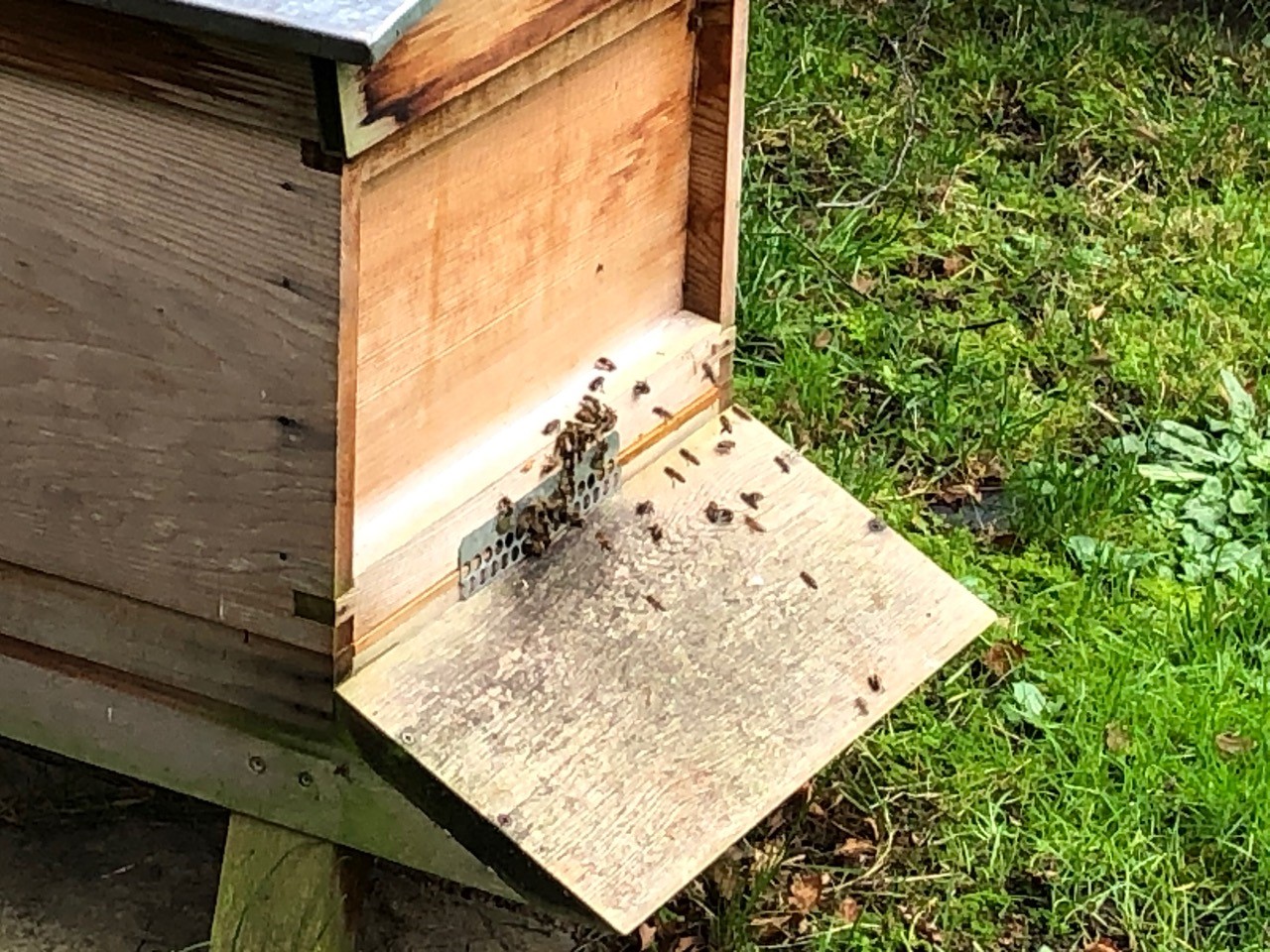Bee Blog February
Feburary 2020
I am Gerald Bushby (pronounced bush bee!) a beekeeper in Weston on the Green, a small village in Oxfordshire. I am going to be writing a monthly blog about the bees in my apiary. I hope you will find it interesting. I should start by saying that I am not an expert, having only kept bees for three years. Anything I say is my own personal opinion; I accept that there may often be other views and opinions.
Will we have an early spring again this year? My photograph this month shows many flying bees during one of several warm days this January. I even saw some bees returning to the hive having collected pollen. This is very early in the year for this to be happening.
Some time ago I started talking about pests and diseases. I will continue this month with another relatively newly introduced, but well known, pest from the east which has been around in this country for longer than the Asian Hornet; the varroa mite. The mite started its travels moving to Japan and the USSR in the 1960’s. It reached the US in 1987 and finally arrived in the UK in 1992. There are now few areas of the world where the varroa mite is not found.
Varroa mites are tiny, the size of a pin head just visible to the naked eye, red brown in colour, that are external parasites to the honeybee. They can only reproduce in a honeybee colony. They feed and live on adult honeybees but they reproduce on larvae and pupae in the developing bee brood, causing malformation of the brood, weakening of the honey bees as well as transmitting numerous viruses. The varroa mite has had a most pronounced adverse economic impact on the beekeeping industry and is considered to be a major stress factor contributing to higher bee losses around the world.
Colonies with low infestation generally show very few symptoms, however as the mite population increases symptoms become more apparent. Heavy Varroa mite infestations can build up in 3–4 years and cause scattered brood, crippled and crawling honeybees, impaired flight performance, a lower rate of return to the colony after foraging, a reduced lifespan and a significantly reduced weight of worker bees. Colony symptoms, commonly called parasitic mite syndrome, include an abnormal brood pattern, sunken and chewed cappings and larvae slumped in the bottom or side of the cell. This ultimately causes a reduction in the honeybee population, supersedure of queen bees and eventual colony breakdown and death.
Varroa mites are not the only organisms found in beehives. Lots of different organisms live alongside the bees, some in harmony, some not. On the larger scale, I have already mentioned previously how mice find hives a great place to overwinter, warm and with a ready supply of food. On the slightly smaller scale earwigs, ants, beetles and wax moths are also commonly found in hives. Over time the honeybees themselves will either live in harmony with these organisms or will control them. The problem with the varroa mite, as with the Asian Hornet I referred to some time ago, is that the honeybees need a long time to adapt.
What can the beekeeper do to control the varroa? Beekeepers have generally reacted in one of two main ways. Firstly, the use of varroacides, treatment with chemicals containing either synthesized proprietary chemicals (so called hard varroacides) or naturally occurring chemicals such as formic acid or essential oils (so called soft varroacides). Secondly the use of biotechnical controls utilising methods that are based on bee husbandry.
As would be expected there are pros and cons of all systems. It is probably fair to say that most conventional beekeepers use a chemical solution. There is however a body of opinion that prefers to use a biotechnical control. I fall into the second category. I do not use chemicals.
My decision to not use chemicals is based on several factors. Primarily I feel that, as far as is humanly possible, I want to produce a natural honey. If I as a beekeeper introduce any chemical into the hive some residue, however small and however said to be safe, may find its way into the honey I collect. Another factor is that going down the varroacides path, the beekeeper has to keep changing the chemical solution used as the varroa mites become resistant and I am concerned that resistant mites breeding with resistant mites may well breed even more resistant mites.
I use a biotechnical control. I encourage the bees to groom themselves by spraying icing sugar onto the bees. Cleaning themselves of this sugar dislodges the varroa from their bodies which fall to the bottom of the hive through a filter and out to the ground below the hive. I also encourage the bees to produce a section of drone comb beneath a shortened frame in the brood box. Varroa prefer to lay eggs in drone comb. When the cone is capped, I remove it from the hive and destroy it along with varroa eggs. The whole process is too labour intensive for most commercial beekeepers who tend to treat their colonies with varroacides.
I am a proud supporter of the ‘Bees for development’ charity, my love of the bee drew me to this wonderful UK based charity and the great work they do around the world with Bees and the impact they can have on people’s lives. Please help me support this wonderful organisation, as 2BScientific will be doing with donations to this hard-working charity.
